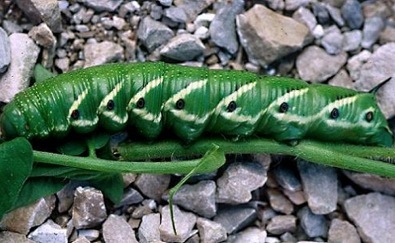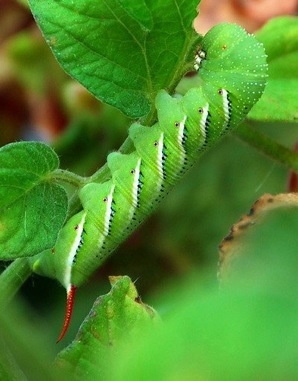
Tomato Horn Worm
Manduca Cuisine: Eating Green Gluttons
You’re picking tomatoes and suddenly there it is: Big, ugly and green, a tomato hornworm. To which I say, get or the frying pan., well, almost.

Tobacco Horn Worm
Up to four-inches long the worm has a horn on the back end. That and its stripes help you identify it because two big worms like your tomatoes. If it has chevrons and a black horn it is Manduca quinqueaculata, the Tomato Hornworm (above) If it has seven diagonal stripes and a red horn, it is Manduca sexta , or the Tobacco Hornworm (right). It would have been nice if they had called the one with the red horn the tomato one but they didn’t. Black horn = Tomato. Red horn = Tobacco. Numerous text and photo entries on the internet have them backwards.
The Tobacco Hornworm (red horn) is found chiefly in southern states, the Tomato Hornworm (black horn) in northern states but neither exclusively so. Both are edible after cleansing. Both are the larval stage of the hawk or sphinx moths and you can find both on the same plant. They are located on the outer areas of the plant at dawn and dusk, near the interior of the plant during the day. The larvae don’t like direct sun.
These hornworms feed only on Solanaceae plants, usually tomatoes or tobacco. However, larvae will also attack eggplant, pepper, and potato. There are many solonaceous weeds that also serve as hosts if tomatoes aren’t around including horsenettle, jimsonweed and various nightshades. Some of those are toxic. That is why you should keep the worm around for a few of days or more and feed it something wholesome (a bit of green pepper or red tomato) before cooking, or starve it for a couple of days until it offloads any toxic frass. Personally I would think twice about eating either hornworm that was found on tobacco. Nicotine is a powerful substance. It is also reduces clotting. Who knows, maybe dried Tobacco Hornworms who fed on tobacco can be used as a blood thinner should society fall apart.
As for the names, the genus Manduca (MAN-doo-ka) means “glutton” because these larvae eat a lot. Sexta means six-fold because the moth has six spots on its underside. Quinquemaculata (quin-cue-mah-cue-LAH-tah) means five spots because the moth has five spots on its underside.
Method of preparation; After purging, gently fried, sauteed if you will, or roast. Natives then strung them on a string and used them as a food necklace while traveling. If you want to raise them for food you can make them an artificial diet. There are several. Here is one:
Ingredients: One cup of non-toasted wheat germ, 1/3 cup non-fat dry milk, 4 tablespoons agar, one teaspoon raw non-boiled linseed oil, 1/2 tablespoon nutritional flake yeast, one 1000 mg vitamin C tablet, two vitamin B tablets, two multivitamin tablets, one tablespoon sugar, 2.5 cups of water.
Place vitamin tablets in a blender and reduce to a powder. Add the wheat germ, powdered milk and sugar. Blend until well-mixed. Remove the dry mix. To the blender add 2.5 cups of boiling water. While set on a low speed, add the agar. Blend for one minute then add the dry mix and mix. Add the linseed oil, increase blender speed and mix well.
If plain sauteing or roasting is not for you here is a recipe from David George Gordon’s “Eat-a-Bug Cookbook”.
3 tbs Olive Oil
16 Tomato Hornworms
16 Basil Leaves
4 Medium Green Tomatoes, 1/4″ Sliced
White Cornmeal
Salt and Pepper (to taste)
1) Lightly fry the Hornworms in a pan for a few minutes. Be careful not
to rupture the exoskeleton with the high heat (aesthetics). Set aside to drain
2) Sprinkle Tomato slices with salt and pepper then coat with cornmeal.
3) Fry Tomato slices on both sides until lightly brown.
4) Top each Tomato slice with one to two Hornworm. Top each Hornworm
with a Basil Leaf.

